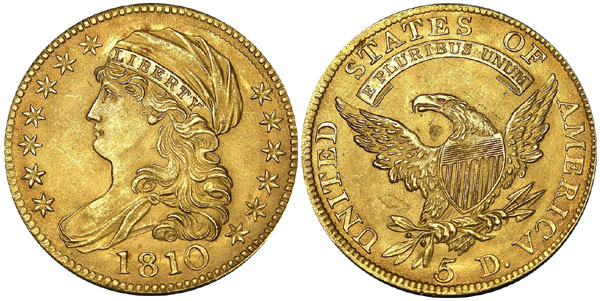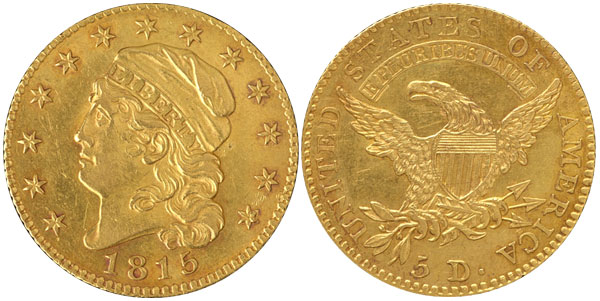Guide to U.S. Capped Bust Half Eagles
The Capped Bust Half Eagle represented the second major series for the five dollar gold denomination. The coins were produced from 1807 to 1834 across three different subtypes. During this period the half eagle became an important denomination within the American monetary system. The production of the larger eagle was under suspension and the smaller quarter eagle was not produced for a period of more than a decade. Although the series often had high mintages, the coins were subject to heavy melting whenever the value of the gold exceeded the face value. This resulted in the creation of a number of important rarities, which only have a handful of examples known to exist.

The half eagle was introduced in 1795, with the initial design produced across two different subtypes until 1807. At that time a new design would be adopted for all gold and silver denominations, representing one of several attempts to standardize the products of the early United States Mint. The new design was created by John Reich, an Assistant Engraver who had joined the Mint only months earlier. His work was not easily accepted by the older employees, however, in modified form it would remain in use across many denominations until the 1830’s.
The obverse design features the head of Liberty, now facing to the left. The upper part of her bust is visible and partly veiled by drapery. She wears a Phrygian or Freedom cap, carrying the word LIBERTY. Long, curling hair extends from under the cap to below the truncation of the neck. Thirteen stars surround the image, configured seven to the left and six to the right. The date is positioned at the bottom rim. This obverse design would be struck from 1807 to 1812 and is usually considered to be the most available of the three subtypes.

In 1813 a variation of the design would be introduced, sometimes referred to as Capped Head or Capped Head to Left. While similar to the initial design, the portrait now includes only the head and neck of Liberty, who carries a somewhat more mature appearance. The thirteen stars are no longer separated by the cap, but appear fully surrounding the image. This subtype would be struck from 1813 to 1829, with the head in slightly higher relief during the first three years.
The third subtype would be introduced in 1829, coinciding with the adoption of closed collar production at the Mint. The diameter of the pieces would be reduced from 25 mm to 23.8 mm, along with slight modifications to the design performed by William Kneass. The primary design elements remained the same, but the stars and lettering were reduced in size. This design would be used until the conclusion of the series in 1834.
The same reverse design would be used across the three subtypes. A bald eagle appears at center with its wings spread, in a more natural position compared to earlier designs. A shield appears at the eagle’s breast and its claws hold an olive branch and three arrows. The motto E PLURIBUS UNUM appears on a scroll placed above the eagle. The denomination expressed as “5 D.” appears at the base with UNITED STATES OF AMERICA surrounding. The reverse would be slightly modified by William Kneass in 1829, most visibly by the smaller lettering.

